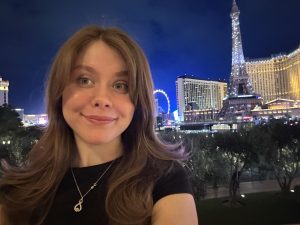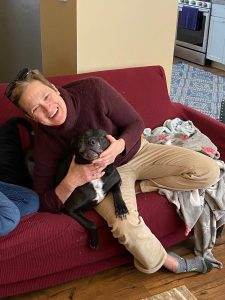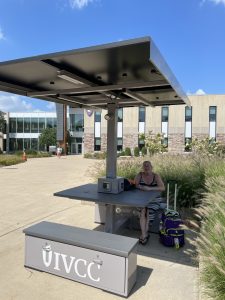What are African-American superheroes trying to say?
Who to watch and learn from
April 26, 2018
On Sept. 16, 2016, Netflix released a straight-to-series season of “Luke Cage” where we were finally introduced to the bulletproof D-list hero, formally known as Marvel’s Power Man, in modern day Harlem.
Only two years later did The CW television network release DC Comic’s Black Lightning about Principal Jefferson Pierce overcoming a strong negative presence toward people of color while also feeling the old spark of his light—Black Lightning. And as of Feb. 16 this year, we encountered the monumental Black Panther.
Already, we have a strong superhero presence from people of color. Filled with morals and ways or steps to deal with life’s issues, these heroes have more to say than just their abilities.
In “Luke Cage,” we discover that he was a framed officer, taking the heat for another, and was imprisoned in a harsh environment where correctional officers and the warden used heavy hitting inmates as boxers for their gambling benefit.
Flash forward some time to his stand alone, he is an escaped convict named Carl Lucas, now hooded under the name of Luke Cage. Luke returns to Harlem and works a field of jobs to make ends meet. Known to the community as a helping hand and a man who stops violence in the community without the use of a gun. This is one message that tells that a hooded black man does not pose a threat, even at his staggering figure of 6 feet 3 inches and over 200 pounds
However, whilst fighting crime, Cage spreads messages of Martin Luther King Jr. and Rosa Parks. He also looks up to the works of Don King and many others to provide a truer, more respectful view of the person of color.
While my best friend had a hard time wanting to watch this show due to its strong color and lack of white characters, he found the capacity to sit forward and binge the show to its end to tell me he thoroughly enjoyed its “black positivity.”
Watching “Cage,” you see some situations like in Episode 3 of “The Defenders”: Luke visits a mother who lost her children to the streets of Harlem. She talks about trying to provide the view of a better life outside of poverty and police brutality, yet she cries out “all my babies are gone.”
This is a sad reality and truth about urban communities, with systemic issues that made and kept ghettos had gone to affect them to the point where life is gangs, drugs, and school-to-prison education.
The most powerful image is a bulletproof black man passively facing off with armed police. Seen as a hero, rapper Method Man says in his Bulletproof Love freestyle, “look dawg, a hero never had one / Already took Malcom and Martin this is the last one,” to say that colored heroes have all be taken from us, they won’t have this one.
That’s where Black Lightning comes in. Affected by an American government-sanctioned drug experiment meant to make the colored city of Freeland ‘docile’ and ‘responsive’ to commands, Jefferson was the lone survivor who accumulated abilities from it.
Although in different companies, Black Lightning, or Principal Jefferson, is shown years after his youth spent being a superhero. He had returned to Freeland after being an Olympic runner and turned its high school into a prep school, serving as its principal.
He negotiated the neutrality of the school’s grounds to gang leaders to allow public growth. One thing gang members would prefer to see is colored youth getting their education.
Jefferson’s presence in Freeland shows us exactly what success looks like in a colored community. He provides foundations of codes and deviates the ‘banging’ out of troubled students. He is a strong colored man who guides the youth.
Another notable character is Inspector Henderson, the Commissioner Gordon of this series, who helps Black Lightning investigate. Although he stays out of battle, he looks out for Freeland and believes in saving Freeland. Although his ex-wife hates the return of his alter ego, he keeps fighting for Freeland because in the end he will regret the chances he never took.
Back to “Cage,” we also have Detective Misty Knight who fights for her city. In Harlem, she works with Cage to fight the negative presence. She is the first colored woman hero to hit the screen. With strength, independence, and her intuition, Misty becomes a force to be reckoned with: a dominant force of woman on the streets of Harlem.
Across the margin, or well overseas, Black Panther hits many views of power. A sovereign country of Africans, Wakanda housed an all-woman elite military guard who spoke several languages and provided a view of girl power to all who watched.
We see a queen whose love provided to all, a teen princess whose brilliance would overthrow herself with more brilliance, and a new king who wished to bestow benevolence and peace to other nations.
We learned from T’challa that “In times of crisis, the wise build bridges, while the foolish build barriers. We must find a way to look after one another as if we were one single tribe.”
But what exactly do these heroes all represent? Beyond a strong representation of ‘black excellence,’ what these people did without their abilities was extraordinary.
These people could lead their communities and provide balance and strength. They could overcome racial oppression with positive messages of unity and combined intelligence.
These people were heroes because of their community work and messages.
Their work was to show that you don’t need abilities to be a good person or to show strength. It was conviction and the knowledge of right and wrong to drive you to do selfless actions.
-Your Web Advisor



